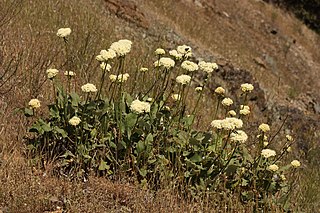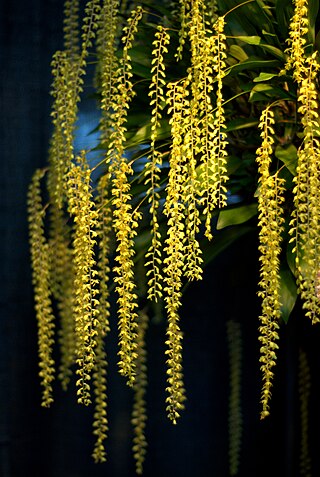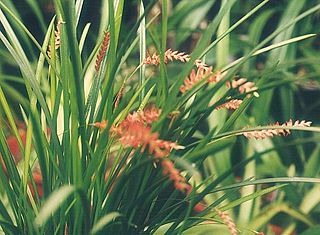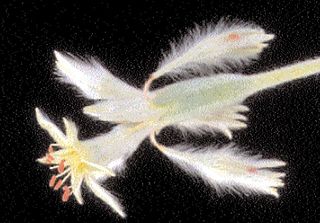
Eriogonum is a genus of flowering plants in the family Polygonaceae. The genus is found in North America and is known as wild buckwheat. This is a highly species-rich genus, and indications are that active speciation is continuing. It includes some common wildflowers such as the California buckwheat.

Paspalum is a genus of plants in the grass family.

Dendrochilum cobbianum, or Cobb's dendrochilum, described by Heinrich Gustav Reichenbach in 1880, is an epiphytic orchid occurring in the Philippines, growing on moss-covered trees. It can sometimes occur as a lithophyte growing on rocks at altitudes above 1200 m.

Dendrochilum was a genus of epiphytic, lithophytic and a few terrestrial flowering plants in the orchid family (Orchidaceae). It is now considered to be a synonym of Coelogyne Lindl. The name of this genus was derived from Ancient Greek words dendron ("tree"), and either cheilos ("lip") or chilos, alluding to either the flowers' large lip or to their epiphytic growth. These orchids are popular among fans of non-traditional orchid curiosities.

Dendrochilum glumaceum, the hay-scented orchid or husk-like dendrochilum, was described by John Lindley in 1841. It is an elegant looking epiphytic or lithophytic dendrochilum that occurs in the Philippines and Borneo at altitudes between 700 and 2,300 m.

Johannes Jacobus Smith was a Dutch botanist who, between years 1905 to 1924, crossed the islands of the Dutch East Indies, collecting specimens of plants and describing and cataloguing the flora of these islands. The standard botanical author abbreviation J.J.Sm. is applied to plants described by J.J. Smith.

Monoon longifolium, the false ashoka, also commonly known by its synonym Polyalthia longifolia, is an Asian small tree species in the family Annonaceae. It is native to southern India and Sri Lanka, but has been widely introduced elsewhere in tropical Asia. This evergreen tree is known to grow over 20 m. in height and is commonly planted due to its effectiveness in alleviating noise pollution. It exhibits symmetrical pyramidal growth with willowy weeping pendulous branches and long narrow lanceolate leaves with undulate margins.

Eriogonum longifolium var. harperi, also known as Harper's buckwheat or Harper's umbrella plant, is a dicot of the family Polygonaceae, found in areas of nutrient-poor shale soils in Alabama, Kentucky and Tennessee. It lives inconspicuously in an immature vegetative stage for four or more years before developing a flowering stalk, then flowers and dies. It is listed as an endangered species by the state of Tennessee. It has eleven small populations in Alabama and five in Tennessee but its survival in Kentucky is uncertain. According to a leading expert, Professor James L. Reveal of the University of Maryland, its Kentucky population has been reportedly extirpated. Its 2006 Alabama Natural Heritage Program ranking was G4T2S1, demonstrating an opinion that it was "critically imperiled" in that state.

Solanum ensifolium is a species of plant in the family Solanaceae endemic to Puerto Rico. Commonly known as erubia, it is nearly extinct due to habitat loss.

Eriogonum longifolium, the longleaf eriogonum or long-leaf wild buckwheat, is a dicot of the family Polygonaceae. In addition to populations of E. longifolium var. longifolium found in Arkansas, Kansas, Louisiana, Missouri, New Mexico, Oklahoma, and Texas, there are varieties or subspecies that are geographically isolated and at various levels of endangerment. According to the University of Michigan Native American Ethnobotony database, Eriogonum longifolium has been used as a food by the Kiowa and as a medicinal by the Comanche.

Eriogonum longifolium Nutt. var. gnaphalifolium Gand., commonly referred to as scrub buckwheat is a dicot of the Polygonaceae family. It is listed as threatened in the US and endangered in Florida. Within Florida its most closely related species is Eriogonum tomentosum however there are three other varieties of Eriogonum longifolium found in other areas of the US.

Veronica longifolia, known as garden speedwell or longleaf speedwell, is a flowering plant in the family Plantaginaceae.
Eriogonum longifolium var. lindheimeri, commonly known as Lindheimer's long-leaf eriogonum and Lindheimer's buckwheat, is a dicot of the family Polygonaceae, found in New Mexico and Texas.

Mount Hamiguitan is a mountain located in the province of Davao Oriental, Philippines. It has a height of 1,620 metres (5,315 ft). The mountain and its vicinity has one of the most diverse wildlife populations in the country. Among the wildlife found in the area are Philippine eagles and several species of Nepenthes. Some of the latter, such as the Nepenthes peltata and Nepenthes micramphora, are endemic to the area. The mountain has a protected forest area of approximately 2,000 hectares. This woodland is noted for its unique pygmy forest of century-old trees in ultramafic soil, with many endangered, endemic and rare species of flora and fauna.

Dendrochilum anfractum is a species of orchid, commonly known as the bent dendrochilum, endemic to Philippines.

Dendrochilum javieriense is a species of orchid, commonly known as Javier's dendrochilum. It is endemic to the island of Luzon in the Philippines.

Dendrochilum magnum is a species of orchid, commonly known as the large dendrochilum, endemic to Philippines.

Conospermum longifolium, commonly known as the long leaf smokebush, is a species of flowering plant of the family Proteaceae and is endemic to New South Wales. It is a dense shrub or undershrub with linear to narrowly lance-shaped leaves, panicles of white flowers and velvety, cream-coloured to dark brown nuts.

Dracophyllum longifolium, commonly called inaka, is an upright shrub or small tree in the family Ericaceae that is endemic to New Zealand.

![]() Media related to Dendrochilum longifolium at Wikimedia Commons
Media related to Dendrochilum longifolium at Wikimedia Commons















